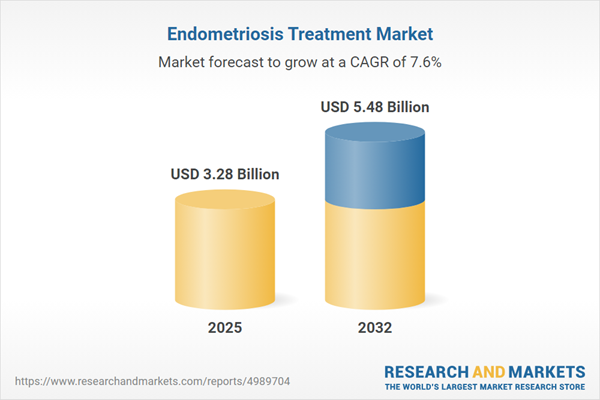Speak directly to the analyst to clarify any post sales queries you may have.
The Endometriosis Treatment Market is rapidly evolving as new therapeutic innovations and patient-centered care models reshape standards of care and drive strategic opportunities for stakeholders across the healthcare sector.
Market Snapshot: Endometriosis Treatment Market Trajectory
The Endometriosis Treatment Market grew from USD 3.05 billion in 2024 to USD 3.28 billion in 2025, supported by a CAGR of 7.58%, and is anticipated to reach USD 5.48 billion by 2032.
Increasing global awareness, earlier diagnosis, and an expanding portfolio of targeted therapeutics are leading to robust demand growth. Pharmaceutical, medical device, and digital health firms are leveraging emerging science and technology to address persistent gaps in diagnosis, therapy, and patient engagement across key regional markets.Scope & Segmentation
- Treatment Type: Complementary therapies, hormonal therapies (aromatase inhibitors, GnRH agonists, GnRH antagonists, oral contraceptives, progestins), pain management (NSAIDs—diclofenac, ibuprofen, naproxen; opioids—codeine, morphine), surgical treatments
- Route of Administration: Injectable, oral, topical
- End User: Ambulatory surgical centers, hospitals, specialty clinics
- Distribution Channel: Hospital pharmacy, online pharmacy, retail pharmacy
- Regions & Sub-Regions: Americas (North America—United States, Canada, Mexico; Latin America—Brazil, Argentina, Chile, Colombia, Peru); Europe, Middle East & Africa (Europe—United Kingdom, Germany, France, Russia, Italy, Spain, Netherlands, Sweden, Poland, Switzerland; Middle East—United Arab Emirates, Saudi Arabia, Qatar, Turkey, Israel; Africa—South Africa, Nigeria, Egypt, Kenya); Asia-Pacific (China, India, Japan, Australia, South Korea, Indonesia, Thailand, Malaysia, Singapore, Taiwan)
- Companies Analyzed: AbbVie Inc., Bayer AG, Teva Pharmaceutical Industries Ltd, Ferring International Center S.A., Mylan N.V., Sandoz International GmbH, Lupin Limited, Pfizer Inc., Sun Pharmaceutical Industries Ltd, Dr. Reddy's Laboratories Ltd.
Key Takeaways
- Therapeutic strategies are transitioning beyond conventional hormonal therapies, increasingly embracing minimally invasive surgical techniques and digital health platforms to enhance patient outcomes and personalization.
- Precision medicine and the application of genomic and proteomic insights are guiding the development of targeted compounds and companion diagnostics, reducing reliance on empirical therapies.
- Digital solutions, such as telemedicine and integrated apps, support remote monitoring and real-time care adjustments, especially in regions with variable healthcare access.
- Multidisciplinary and patient-engagement frameworks are restructuring care delivery, ensuring that treatment endpoints reflect quality-of-life concerns and informed decision-making.
- Supply chain adjustments and regional disparities require tailored market entry and competitive strategies, particularly in response to recent geopolitical and regulatory developments.
Tariff Impact: Navigating Cost Pressures and Strategic Realignment
Tariff measures introduced in the United States in 2025 elevated supply chain and production costs for endometriosis therapeutics and devices. Companies are adopting a mix of cost absorption, supply chain diversification, and strategic sourcing from tariff-exempt jurisdictions to maintain pricing competitiveness while ensuring uninterrupted product availability. These shifts influence accessibility and reimbursement, as regional manufacturers with optimized production may achieve preferable market positions.
Research Methodology & Data Sources
This report combines in-depth secondary research with interviews from clinical experts and supply chain leaders across key sectors. Data triangulation using SWOT, benchmarking, and scenario planning underpins objective market insights. Rigorous validation by research analysts ensures analytical accuracy and relevance for strategic decision-makers.
Why This Report Matters
- Enables senior leaders to identify therapeutic and technology trends that inform R&D, commercialization, and regional go-to-market strategy.
- Supports supply chain optimization and risk mitigation planning in light of evolving trade policies and local production dynamics.
- Equips stakeholders with actionable intelligence to optimize patient engagement, payer negotiation, and innovation investments in an increasingly competitive landscape.
Conclusion
The Endometriosis Treatment Market offers measurable growth prospects as advances in precision medicine, digital health, and collaborative care intersect with regional dynamics. Strategic adaptation to segment shifts and supply chain realities will define success for stakeholders pursuing leadership in this evolving sector.
Additional Product Information:
- Purchase of this report includes 1 year online access with quarterly updates.
- This report can be updated on request. Please contact our Customer Experience team using the Ask a Question widget on our website.
Table of Contents
3. Executive Summary
4. Market Overview
7. Cumulative Impact of Artificial Intelligence 2025
Companies Mentioned
The companies profiled in this Endometriosis Treatment market report include:- AbbVie Inc.
- Bayer AG
- Teva Pharmaceutical Industries Ltd
- Ferring International Center S.A.
- Mylan N.V.
- Sandoz International GmbH
- Lupin Limited
- Pfizer Inc.
- Sun Pharmaceutical Industries Ltd
- Dr. Reddy’s Laboratories Ltd.
Table Information
| Report Attribute | Details |
|---|---|
| No. of Pages | 191 |
| Published | November 2025 |
| Forecast Period | 2025 - 2032 |
| Estimated Market Value ( USD | $ 3.28 Billion |
| Forecasted Market Value ( USD | $ 5.48 Billion |
| Compound Annual Growth Rate | 7.5% |
| Regions Covered | Global |
| No. of Companies Mentioned | 11 |









